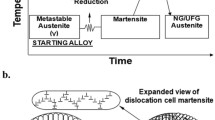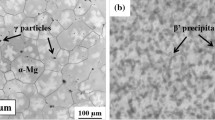Abstract
The effect of specimen thickness on fracture toughness and fracture mechanism was investigated in bulk columnar-grained Cu with preferentially oriented nanoscale growth twins. Below a critical specimen thickness of ∼1.0 mm, plane stress state prevailed ahead of the crack tip and the fracture initiation toughness JC decreased with decreasing thickness. Above the critical thickness, JC decreased with increasing thickness until approaching an intrinsic thickness-independent value when the crack front was mainly under plane strain condition. Under plane strain condition, threading dislocations were majorly activated to glide along the nanotwin channels and to produce severe stress concentrations when they piled-up against grain boundaries (GBs). As a result, intergranular cracking mediated the failure of the nanotwinned Cu. On the contrary, under plane stress condition, dislocations slipping-transfer across twin boundaries (TBs) or partial dislocations gliding at TBs were activated to accommodate the plastic deformation. Consequently, stress intensification at GBs was plastically relaxed through enhanced detwinning and shear banding, which suppressed the intergranular fracture and promoted transgranular shear fracture.








Similar content being viewed by others
References
L. Lu, Y. Shen, X. Chen, L. Qian, and K. Lu: Ultrahigh strength and high electrical conductivity in copper. Science 304 (5669), 422 (2004).
K. Lu, L. Lu, and S. Suresh: Strengthening materials by engineering coherent internal boundaries at the nanoscale. Science 324 (5925), 349 (2009).
L. Lu, X. Chen, X. Huang, and K. Lu: Revealing the maximum strength in nanotwinned copper. Science 323 (5914), 607 (2009).
C.J. Shute, B.D. Myers, S. Xie, T.W. Barbee, Jr., A.M. Hodge, and J.R. Weertman: Microstructural stability during cyclic loading of multilayer copper/copper samples with nanoscale twinning. Scr. Mater. 60 (12), 1073 (2009).
C.J. Shute, B.D. Myers, S. Xie, S.Y. Li, T.W. Barbee, Jr., A.M. Hodge, and J.R. Weertman: Detwinning, damage and crack initiation during cyclic loading of Cu samples containing aligned nanotwins. Acta Mater. 59 (11), 4569 (2011).
Z.S. You, L. Lu, and K. Lu: Tensile behavior of columnar grained Cu with preferentially oriented nanoscale twins. Acta Mater. 59 (18), 6927 (2011).
Z.W. Shan, L. Lu, A.M. Minor, E.A. Stach, and S.X. Mao: The effect of twin plane spacing on the deformation of copper containing a high density of growth twins. JOM 60, 71 (2008).
E.W. Qin, L. Lu, N.R. Tao, J. Tan, and K. Lu: Enhanced fracture toughness and strength in bulk nanocrystalline Cu with nanoscale twin bundles. Acta Mater. 57 (20), 6215 (2009).
L. Xiong, Z.S. You, and L. Lu: Enhancing fracture toughness of nanotwinned austenitic steel by thermal annealing. Scr. Mater. 119, 55 (2016).
L. Xiong, Z.S. You, and L. Lu: Fracture behavior of an austenitic stainless steel with nanoscale deformation twins. Scr. Mater. 127, 173 (2017).
H. Zhou and S. Qu: The effect of nanoscale twin boundaries on fracture toughness in nanocrystalline Ni. Nanotechnology 21 (3), 035706 (2010).
H. Zhou, S. Qu, and W. Yang: Toughening by nano-scaled twin boundaries in nanocrystals. Modell. Simul. Mater. Sci. Eng. 18 (6), 065002 (2010).
L. Liu, J. Wang, S.K. Gong, and S.X. Mao: Atomistic observation of a crack tip approaching coherent twin boundaries. Sci. Rep. 4, 4397 (2014).
Z. Zeng, X. Li, L. Lu, and T. Zhu: Fracture in a thin film of nanotwinned copper. Acta Mater. 98, 313 (2015).
S-W. Kim, X. Li, H. Gao, and S. Kumar: In situ observations of crack arrest and bridging by nanoscale twins in copper thin films. Acta Mater. 60 (6–7), 2959 (2012).
S.S. Luo, Z.S. You, and L. Lu: Intrinsic fracture toughness of bulk nanostructured Cu with nanoscale deformation twins. Scr. Mater. 133, 1 (2017).
E.W. Qin, L. Lu, N.R. Tao, and K. Lu: Enhanced fracture toughness of bulk nanocrystalline Cu with embedded nanoscale twins. Scr. Mater. 60 (7), 539 (2009).
T. Zhu and H. Gao: Plastic deformation mechanism in nanotwinned metals: An insight from molecular dynamics and mechanistic modeling. Scr. Mater. 66 (11), 843 (2012).
Z. You, X. Li, L. Gui, Q. Lu, T. Zhu, H. Gao, and L. Lu: Plastic anisotropy and associated deformation mechanisms in nanotwinned metals. Acta Mater. 61 (1), 217 (2013).
A. Kobler, A.M. Hodge, H. Hahn, and C. Kübel: Orientation dependent fracture behavior of nanotwinned copper. Appl. Phys. Lett. 106 (26), 261902 (2015).
Z. You and L. Lu: Effect of strain rate on tensile ductility and fracture behavior of bulk nanotwinned copper. Adv. Eng. Mater. 17 (12), 1754 (2015).
D. Jang, X. Li, H. Gao, and J.R. Greer: Deformation mechanisms in nanotwinned metal nanopillars. Nat. Nanotechnol. 7 (9), 594 (2012).
X. Zhao, C. Lu, A.K. Tieu, L. Pei, L. Zhang, L. Su, and L. Zhan: Deformation mechanisms in nanotwinned copper by molecular dynamics simulation. Mater. Sci. Eng., A 687, 343 (2017).
D.C. Bufford, Y.M. Wang, Y. Liu, and L. Lu: Synthesis and microstructure of electrodeposited and sputtered nanotwinned face-centered-cubic metals. MRS Bull. 41 (7), 286 (2016).
ASTM E1820-16: Standard Test Method for Measurement of Fracture Toughness (ASTM International, West Conshohocken, PA, 2016). www.astm.org.
M.D. Merz and S.D. Dahlgren: Tensile strength and work hardening of ultrafine-grained high-purity copper. J. Appl. Phys. 46 (8), 3235 (1975).
A.M. Hodge, Y.M. Wang, and T.W. Barbee, Jr.: Mechanical deformation of high-purity sputter-deposited nano-twinned copper. Scr. Mater. 59 (2), 163 (2008).
Y. Zhang, N.R. Tao, and K. Lu: Mechanical properties and rolling behaviors of nano-grained copper with embedded nano-twin bundles. Acta Mater. 56 (11), 2429 (2008).
M.E. Launey and R.O. Ritchie: On the fracture toughness of advanced materials. Adv. Mater. 21, 2103 (2009).
A.R. Shahani, M. Rastegar, M. Botshekanan Dehkordi, and H. Moayeri Kashani: Experimental and numerical investigation of thickness effect on ductile fracture toughness of steel alloy sheets. Eng. Fract. Mech. 77 (4), 646 (2010).
Y.T. Zhu, X.Z. Liao, and X.L. Wu: Deformation twinning in nanocrystalline materials. Prog. Mater. Sci. 57 (1), 1 (2012).
Q. Lu, Z. You, X. Huang, N. Hansen, and L. Lu: Dependence of dislocation structure on orientation and slip systems in highly oriented nanotwinned Cu. Acta Mater. 127, 85 (2017).
ACKNOWLEDGMENTS
The authors acknowledge financial support from the National Natural Science Foundation of China (Grant Nos. 51420105001, 51371171, 51471172, 51401211, and U1608257) and the Key Research Program of Frontier Sciences, Chinese Academy of Sciences. Z.Y. acknowledges financial support by Natural Science Foundation of Jiangsu Province, China (Grant No. BK20161498).
Author information
Authors and Affiliations
Corresponding author
Additional information
This author was an editor of this journal during the review and decision stage. For the JMR policy on review and publication of manuscripts authored by editors, please refer to http://www.mrs.org/editor-manuscripts/.
Rights and permissions
About this article
Cite this article
Luo, S., You, Z. & Lu, L. Thickness effect on fracture behavior of columnar-grained Cu with preferentially oriented nanoscale twins. Journal of Materials Research 32, 4554–4562 (2017). https://doi.org/10.1557/jmr.2017.309
Received:
Accepted:
Published:
Issue Date:
DOI: https://doi.org/10.1557/jmr.2017.309




